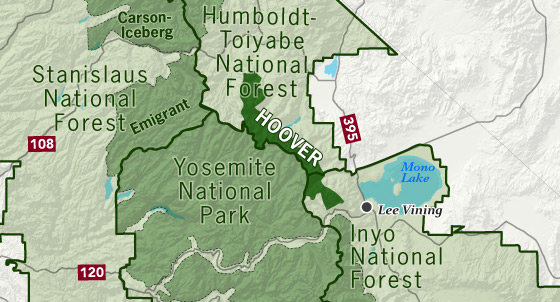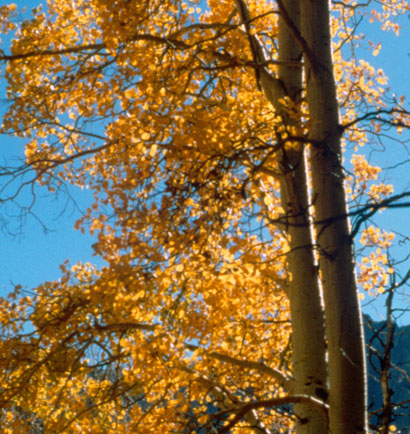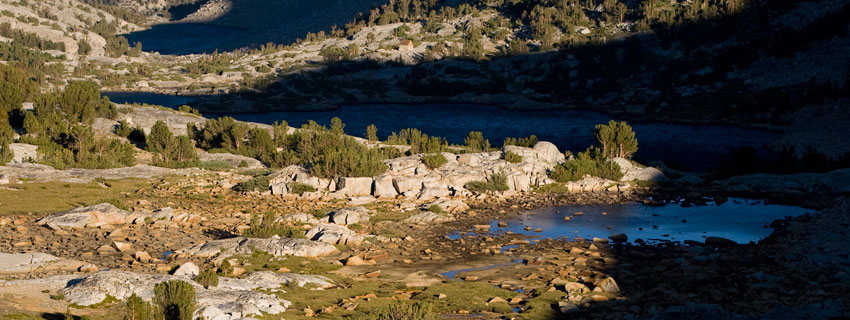
Sharing a boarder with the Yosemite Wilderness along the Sierra crest, the Hoover is widely known for its extreme mountain terrain. The wilderness was first established as a “primitive area” in 1931 and was then protected as wilderness in the 1964 Wilderness Act.
The Hoover has relatively little timber throughout much of its steep terrain. Its forests are composed of scattered groves of hemlock, pine, aspen, and cottonwood. Diverse wildflowers spread over the intermittent meadows found here and black bears are common.

Getting There
The Hoover is easily reached from its southern end (along Highway 120 near Yosemite’s Tioga Pass entrance station), as well as from various points along its eastern edge near Highway 395. Many hikers pass through the Hoover wilderness to visit otherwise remote areas of Yosemite Wilderness. See the sidebar for public transportation options.
WILDERNESS PERMITS
Wilderness permits are required for all overnight use in the Hoover Wilderness. Day use does not require a wilderness permit. The requirements for wilderness permits are different on the Inyo and Humboldt-Toiyabe portions of the wilderness. Please note the trailhead where you plan to begin your trip, and which forest it is on. You will need to apply for a wilderness permit from the forest where your trip starts. If your trip begins in the Hoover Wilderness but will take you into Yosemite Wilderness, or beyond, you do not need a separate wilderness permit from Yosemite National Park (with a few exceptions).
For the Humboldt-Toiyabe portion: A quota season for wilderness permits is in effect from the last Friday in June through September 15 of each year. During the quota season, the number of wilderness permits available are limited by trailhead. Half of the available wilderness permits for each day are available for reservation, and half are available for first come-first serve issue on the date of entry. The quota for each trailhead varies in size. Wilderness permit reservations are accepted beginning on March 1 of each year. Outside the quota season, wilderness permits are available at the Bridgeport Ranger Station. For further information about quotas, reservations, and other wilderness permit-related questions, please contact the Bridgeport Ranger District.
Humbodlt-Toiyabe National Forest
If you plan to enter the wilderness at Twin Lakes, Virginia Lakes or entry points to the north, apply to Humboldt-Toiyabe NF. Reservations are available six months in advance of the desired entry date, through recreation.gov. Walkup permits can be obtained at the Bridgeport Ranger District Office. See the links in the sidebar for more detailed permit information, anc check their website for updates.
Inyo National Forest
For trips entering at Lundy Canyon, Lakes Canyon, or Saddlebag Lake, reservation requests can be made through recreation.gov. Call the Mono Basin Scenic Area Visitor Center permit office at 760-873-2483 for more information, or visit the links in the sidebar.
MAXIMUM GROUP SIZE
No more than 15 people and 25 head of stock are allowed on overnight trips. In the Saw tooth Ridge Zone in the Humboldt-Toiyabe National Forest portion of the Hoover Wilderness, the maximum group size is 8 people and no stock.

BEARS AND FOOD STORAGE
The Inyo and Humboldt-Toiyabe National Forests each have a forest order regarding food storage.
In the Humboldt-Toiyabe portion of the Hoover Wilderness, proper food storage is required by forest order. What this means is that bear canisters are required for food storage. Hanging of food is not acceptable. The Humboldt-Toiyabe applies the same criteria that Yosemite National Park uses for acceptable and approved bear canisters.
In all wilderness areas of Inyo National Forest use of bear-resistant containers is strongly recommended. In eight specific areas it is mandatory to store food and refuse in a container designed to prevent access by bear. Where food storage containers are not mandatory the counter balance method of hanging food may be used, however where trees are not adequate for hanging food at least 15 feet above ground and 10 feet away from the tree trunk you must use a portable food storage container. No other methods of food storage are allowed.
Food storage containers are available for rent or sale at all the Inyo National Forest visitor centers where wilderness permits are issued.
More information about traveling in bear country in Inyo National Forest
CAMPFIRES
In general, campfires are allowed in the Humboldt-Toiyabe portion of the Hoover Wilderness, with the following exceptions:
- Above 9,000 feet within the Virginia and Green Creek drainages
- Within 1/4 mile of Barney and Peeler Lakes
- In the 20 Lakes Basin (the Saddlebag Lake area)
- In the Sawtooth Ridge Area.
In places where fires are allowed, make sure to always follow smart campfire guidelines.
PETS
- Dogs are allowed in the Hoover Wilderness, but are not allowed in wilderness areas in adjacent national parks.
- Pet food must be stored to the same standard as people food. In areas where use of a bear resistant food storage container is required, pet food must be stored in your container.
- Leashes protect dogs from becoming lost and from wilderness hazards such as porcupines, mountain lions, and sick, injured or rabid animals.
- Unleashed dogs may intimidate other hikers and their dogs, depriving them of a peaceful wilderness experience.
- Unleashed dogs may harass, injure and sometimes kill wildlife.
- A leashed dog’s keen senses can enhance your awareness of nearby wildlife or other visitors.
OTHER CONSIDERATIONS
- Whenever possible, camp more than 100 feet away from any lakeshore, stream and trail
- One night limit at Barney Lake.
- No camping within 100 feet of Barney Lake.
- No camping at Red Lake, Blue Lake or Virginia Lake.
- No camping in the Hall Natural Area or at Saddlebag Lake.
- Within the Saw tooth Ridge Zone, campfires are not allowed, maximum group size is 8 people, stock are not allowed, and there is no camping allowed within 100 yards of trails or established routes.
